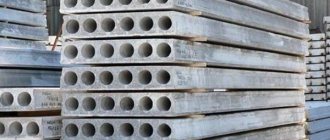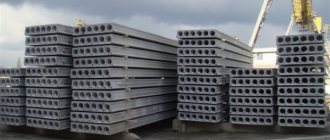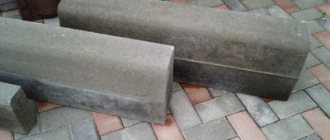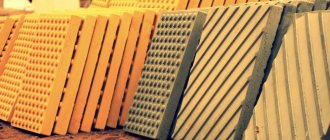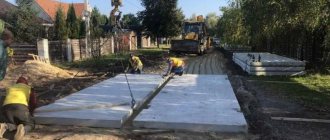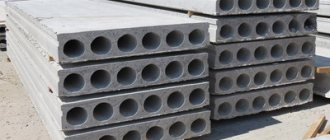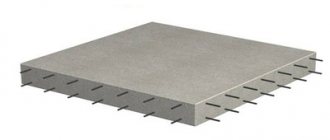Although residents of country villages want to be closer to nature, they cannot do without certain elements of landscaping. In this case we are talking about paths that can be comfortable and functional. In addition, they are able to improve the entire village.
On your site, you can use natural stone pavements, but for public streets, road slabs are still suitable, the dimensions of which are regulated by state standards. These products are quite actively used by development companies and cooperatives.
Purpose
Reinforced concrete slabs are a truly unique material that is used to make roads. They are able to endure high loads. The purpose of the products is very different. This should include the construction of temporary roads and the creation of permanent underground routes. In the first case, the roads are intended for construction projects, in the second, the roads lead to enterprises, as well as sparsely populated areas in rural areas, which are located an impressive distance from the main roads.
Laying technology allows roads to be built in any area and used quite actively. Asphalt can be installed on the surface of the slabs, which can protect the material and extend the life of the sheet. A nice feature of using reinforced concrete products is the possibility of their reuse if the slab has characteristics that have not been lost. This allows you to save money. The slabs can be used to construct a high-quality road surface that will be used temporarily.
Benefits of technology
- The method of building roads from slabs has a number of undeniable advantages, including:
- high speed of laying the canvas, which is the surface of finished reinforced concrete products;
- the strength and reliability of the coating, the production of which is carried out in the factory;
- extremely high service life, which is due to the quality of manufacturing of reinforced concrete products;
- ease of installation, for which crane equipment is used;
- reduced requirements for preparing the base for reinforced concrete products;
- versatility of technology. The road surface, made of slabs based on reinforced concrete, is not demanding on climatic conditions and can be used without destruction in the temperature range from -50 to + 55 degrees;
- the possibility of dismantling temporary roads, as well as unused road surfaces, with the possibility of reusing reinforced concrete products that have not exhausted their strength life.
Dimensions according to state standards and some design features
The products described are flat rectangular reinforced concrete slabs, the thickness of which varies from 14 to 18 cm. The slabs are made on the basis of stressed or unstressed reinforcement. The working surface is corrugated. There are mounting loops along the end faces, but the slabs can be constructed without loop grips. The hinges are in molded recesses to prevent exposure to the outer surface.
The dimensions of road slabs can be selected individually, taking into account preferences. Concrete acts as a binder. It gives rigidity to the product and resistance to mechanical and atmospheric influences. The higher the grade of concrete, the more impressive loads the structure can take on. The weight of the slab is usually 2200 kg minimum. Concrete can have a density ranging from 2200 to 2500 kg per meter.
Features of installation of road slabs
The process of constructing a road from these structures consists of several stages:
- leveling the soil surface;
- preparing a trench for water exchange;
- laying a layer of crushed stone (material thickness - up to 10 cm);
- soil compaction using a vibrating plate;
- laying road slabs;
- processing of joints.
After this, the soil is compacted using vibrating plates. For large areas, specialists use a roller. The level of soil subsidence is determined using a level. The final stage is the laying of road slabs; the structures are placed sequentially. The tensioned cord is the main guide for the first row of road slabs. Depending on the technology, road slabs can be laid with a gap or joint to joint. After this, the seams are covered with sand, grain screenings or filled with bitumen. To avoid the formation of cracks, the seams are expanded using a wet solution.
This is interesting: How to style medium hair in 2019
For greater strength, the mounting loops are welded together. A significant advantage is that this design can serve as a reliable platform for road surfaces. To construct such a road, it is recommended to choose high-quality concrete slabs from the manufacturer. Reinforced concrete products made in accordance with basic requirements will last a long time. Such a road will be distinguished by its reliability, durability, and increased resistance to various negative factors.
Depending on the volume of work, installation of road slabs takes varying amounts of time - from several months to six months (in the case of regular work). At various stages of installation, specialists control the horizontal position of the slabs using a level.
What are they made from?
The basis is often concrete with frost resistance up to W2 and F150. Road slabs, the weight and size of which affect the price, have steel rods inside. Thanks to them, the structure is ready to serve for a long time, maintaining its original properties. For stressed slabs, the following classes of reinforcement are used:
- At-4.
- At-5.
- A-5.
If you have a non-tensioned slab in front of you, then in the process of its production we use reinforcement of grades A-3C, A-3 and A-1, as well as BP-1 wire. The rods are protected from exposure to sunlight, precipitation and mechanical influences. During installation, the slabs return to their original position.
The voltage generated in normal mode is minimal. As for the sizes of road slabs, they are sold with the following parameters: length ranging from 1.75 to 6 m. Width from 1.5 m to 3.75 m. Products are stacked in stacks no more than 2 m high. In this case, the bottom row is located on a dense and leveled base. Each product is placed on wooden spacers.
Design features and scope
The technology for laying concrete slabs is based on calculating the load acting on the sheet.
Slabs are made from various grades of concrete. The average weight of one road unit is 2–2.3 tons, and its thickness is about 18–20 cm.
Commonly accepted canvas sizes:
- 1.75; 1.87;3–3.5–3.75 with a total flooring length of up to six m;
- 2.76 has a length of 3.5 m;
- 1.5 has a length of 1.76 m.
Road surfaces are also divided into 2 types:
- 1P – used on an ongoing basis;
- 2P – temporary road decking.
Storing the canvas is allowed at a height of up to two m, and wooden beams are fixed between the rows. Reinforced concrete slabs are often used in garden plots as pedestrian paths due to the ease of installation, replacement and general availability of the material.
Main types
The dimensions of road slabs are not all that you need to know about these products. It is also important to take an interest in the main types. Each of them defines a purpose. The slabs can be intended for permanent work and for temporary road surfaces. Based on their shape, the slabs can be classified into trapezoidal, hexagonal and rectangular. The latter have one side on the long side or two sides on the short side. Hexagon-shaped slabs can have a diagonal orientation, transverse or hexagonal shape, which is divided in half.
If you have a hexagonal shape in front of you, then it can also be divided in half across. The sizes of road concrete slabs are very varied, as are their shapes, but factories usually produce rectangular products for permanent and temporary roads. The surface can withstand up to 30 tons. Looking at the markings, you will see the permissible load level. The most popular slabs are those that have stressed reinforcement inside. They have certain restrictions on loads when regularly moving large, heavy vehicles, but this is not relevant for laying them at home.
Classification
The production of road reinforced concrete slabs is carried out in accordance with the regulatory requirements of the GOST 21924.0-84 standard, according to which the products are graded into three main categories:
- RDP are the most popular and widespread reinforced concrete slabs of a universal type, which are used when it is necessary to construct permanent and temporary roads with an average load level of no more than 6 tons per wheel. The products can be reused after dismantling. Their load capacity is 10 - 30 tons and depends on the brand of concrete used in the manufacture. Precast concrete products are designed for operation in severe frost conditions – down to – 50 °C;
- PDN – products made on the basis of reinforced concrete with a prestressed reinforcement structure. Having increased load characteristics, the dimensions of the reinforced concrete products are 6000 mm in length and 2000 mm in width with a weight of 4200 kg. Due to the strength of the body due to the rigidity of the reinforcement frame, the products are recommended for use in heaving and soft types of soil;
- PAG is the most durable type of airfield slabs. The average weight of a product unit is 5 tons. Precast concrete products are focused on the construction of roads for heavy types of transport, as well as the construction of runways for aviation (PAG-18, as well as PAG-14). Structurally, the elements can have a smooth or corrugated surface, providing different grip on vehicle wheels. In the production of products, concrete mortar with grades from M350 to M400 is used. The maximum load reaches 75 tons. The products can be used at temperatures down to -35 °C.
More about sizes
The size of the road slab 2p30 18 is presented in 2 options: 3 x 1.75 and 6 x 2 m. Previously, panels with parameters 3 x 1.5 m were produced. Currently, they are not produced and may cost more than products with standard parameters. Considering the dimensions of the road slab 2p30 18 30, you can note for yourself that the thickness of the product is 18 cm. This is true for the first of the panels mentioned. For the second size, the thickness can be 14 or 18 cm.
The production of slabs is possible in 2 types of reinforcement: pre-stressed and without pre-stress. You can recognize the first products by the markings, looking at which you will see the AtV add-on. The working surface should be corrugated, which ensures better bonding with the applied asphalt.
Laying features
If you decide to lay road slabs, you must first prepare the base. Installation on the ground is not permitted. The first step is to prepare the bed for your patio or walkway. To do this, the top layer of soil is removed, the surface must then be leveled and all unevenness removed.
A 25 cm trench is dug according to the markings. On clay soils and loams in lowlands, the depth of the trench should not be less than 0.5 m. The bottom is covered with non-woven material, which can be used as geotextiles. It will prevent the growth of weeds and the washing out of the sand and gravel base.
Road laying technology
The construction of slab roads is a simple technological process that consists of a number of stages:
- laying requires a flat surface, for which, as a rule, the top layer of soil is cut off;
- to ensure the outflow of rain, as well as melt and groundwater, a small trench is dug on the surface, 25 - 50 cm deep;
- in order to prevent the destruction of the road due to washing out, as well as the appearance of unwanted plants, the laying surface is covered with a geotextile-based fabric;
- a cushion is formed on the prepared surface, 20-25 cm wide, consisting of crushed stone and sand, which is well wetted with water and compacted before laying the slabs;
- To lay the slabs evenly, a guide line in the form of a stretched cord is used. Reinforced concrete products are laid sequentially using a crane. The work is carried out by one team of workers with a crane operator and a slinger who hooks the slabs to the mounting loops;
- finished slabs can be compacted when adjusted manually using bench tools;
- in order to ensure the immobility of reinforced concrete products in a fixed position, side mounting loops can be used to connect elements to each other using steel rods and electric welding.
Preparatory layer
You now know the dimensions of road slabs according to GOST, but this is not all the knowledge that you should have before starting installation. The next step is to fill the trench with crushed stone. For a garden path, 5 cm will be enough, for a driveway or parking lot - 10 cm. Next comes a 10 cm layer of sand. It is compacted and watered. It is better to use quarry sand, since it is not as dusty and creeping as river sand, and it is much easier to compact it.
The sand is then compacted using a vibrating plate. If there is none, you can use a vibrating roller, but the cost of laying slabs using this technology is much more expensive. Tamping must be controlled by a level or rope beacon. After compacting is completed, the surface should be perfectly flat, because reinforced concrete slabs will be laid on it.
Where can I order the construction of a road from road slabs?
A large number of unscrupulous companies lay road slabs on a very thin layer of sand. Due to this, they are able to save a decent amount. But slabs on such a cushion cannot be fully used. Such a road will begin to collapse after the first winter.
Our company values its reputation. That is why we carry out all work in accordance with norms and standards. There is not a single negative review about the work carried out by our company. All our clients are satisfied and recommend our services to others.
Paving the path
The dimensions of the PAG road slab (smooth airfield slab) were mentioned above. For a successful result, it is also important to become familiar with how paving is carried out. For example, it is important to know that when arranging a route you should not get carried away with sharp turns and bends. Absolutely straight paths are also not an option that looks natural. The width is selected taking into account the logic of movement around the territory. It is important to link this parameter with the dimensions of the cleaning equipment you plan to use for maintenance. The width of the path that will be used at home is usually 1.5 m. If you plan to pave pedestrian paths, you can get by with a width of up to 80 cm.
Hard surfaces can be laid dry or wet. In the first case, the products are fitted tightly to each other. The gap is about 3 mm. The seams are filled with sand and spilled with water. The dimensions of road slabs (PD) are regulated by state standards. When purchasing, it is important to pay attention to this characteristic. You also need to consider which slab laying technology is right for you. It can be wet and involve the use of cement-sand mortar. Thanks to this, the coating adheres well to the gravel base.
At home, you can consider an intermediate option. In this case, the slabs are placed on a dry cement-sand mixture, and then the coating is spilled with water. The stones and the underlying layer are then set together.
You can do the following. The plates can be arranged sequentially. It is necessary to stretch a cord along the edge of the path, which will be used as a guide when laying the first row. The first slab is raised, and then a solution must be applied to the sand at 5 points, after which the slab is returned back. It is brought down using a board and a sledgehammer. The remaining slabs can be laid according to the same principle. Wooden planks 8 mm thick are laid between the elements. The horizontality of the masonry can be controlled by the building level.
The slabs can be laid not only end-to-end, but also with a certain gap, which is then filled with stone, cement mortar and sand. In order to prevent scratching of the slabs, the seams are sewn together with a damp solution. Products can be pre-protected with adhesive film. The boards must be removed after completion of the work, and the solution will dry in 2 days. Seeds are planted in the gap between reinforced concrete products.
What needs to be done to build a new road? Slab laying technology.
Before building a road, it is necessary to determine the allocated budget and only then make an estimate. Here, by the way, check out the GOST dimensions of road slabs.
To lay a new road in a new place, you need to do the following:
1. Decide how wide the road will be:
- for the passage of two cars, so that they can pass each other at low speeds, 2.0 - 2.2 m of width for a passenger car and 2.5 - 2.7 m for a truck are sufficient. Therefore, the minimum width of the simplest road should be 4.5 m wide and 30–50 cm wide for the crushed stone curb on each side of the hard surface.
2. Lay out the main axis of the road on the ground.
3. Measure 2.75 m from the axis on both sides and put marks - wooden pegs.
4. Remove fertile soil from the marked area to a depth of at least 40–55 cm. This is done with a bulldozer or scraper (on large construction sites). The removed soil is stored aside for further use. If the soil on the territory of the future road is not fertile, then it can (or should) be removed for filling, for example, at the beginning of a ravine or to another place.
5. Fill the resulting wide and shallow trench with a layer of crushed stone or gravel, at least 150 - 200 mm thick, and level it. Pour a layer of sand of the same thickness on top. After leveling, pour water over the sand and compact it with a vibrating board or tamper.
6. Restore the markings of the main axis of the road. For this it is better to use pieces of reinforcement.
7. Lay the slabs of the selected size using a crane, as tightly as possible. In this case, the lifting mechanism can drive onto already laid slabs and thereby compact their fit.
This is interesting: Laying rolled lawn price per m2 2022
8. To prevent the slabs from moving left and right during operation, use pieces of reinforcement from the main axis of the road. Use them to weld the hinges of adjacent slabs.
9. Prepare a cement-sand mortar (in a ratio of 1: 3) and filling the voids of the slabs in the hinge area with fine gravel, concrete them flush with the surface of the slab. Only fill longitudinal seams. Transverse seams are intended to act as thermal compensators and must be filled with bitumen mastic or other elastic material.
10. Roadsides - the area between the slab and the edge of the road pit should be filled with crushed stone or gravel. If there is sandy-rocky soil or a quarry nearby, then the aggregate can be brought from there. The filling should have a small margin for shrinkage.
The road has been built, use it until the next crossing.
Explanation of the abbreviation 2P30.18-30
The dimensions of road slabs according to GOST are now known to you. Surely you want to know what the abbreviation in the name means. The size of this product is 3000x1750x170 mm. Its cost is 7500 rubles. If the marking contains the number 2, it means that the slab is intended for temporary roads. If you want to purchase products for permanent roads, you should pay attention to those marked with the number 1.
The letter P indicates the shape of the slab - rectangular. Its nominal length in decimeters is 30. The permissible load in tf/m is 30. The nominal width in decimeters is 18.
This type of slab is used everywhere in the construction of road surfaces of any type, in the construction of roads in the difficult climate of the North, since this type of product demonstrates excellent performance characteristics even in permafrost conditions. Thanks to such slabs, construction time can be significantly reduced. The mass of the plate is 2200 kg.
Types of road slabs
Road slabs are divided depending on their characteristics into the following types:
- 2P 30 - mainly used when arranging temporary coverings, since these slabs can withstand a load of no more than 30 tons;
- PDP 3 - this type of road slabs is universal. It can be used both for the construction of permanent coverings and for the installation of temporary foundations.
- 1P30 slabs are used for the construction of permanent roads.
In addition, there is a special type of road slabs, marked with a letter designation - PDN.
These slabs have a heavy-duty frame, and their main purpose is the construction of road surfaces in extremely difficult conditions.
Road slab laying technology
You should know that laying road slabs involves a certain stage of preparing the base for these purposes, since it is impossible to simply lay reinforced concrete slabs on the ground. To lay the foundation, first the top soil is removed, then the area intended for the road is leveled.
After this, using special equipment, a trench is torn to a depth of at least 30 cm. To prevent the road slabs from being washed away by water in the future, a geotextile film is spread at the bottom of the trench. Then a cushion under the road slabs is laid on the geotextile, consisting of a 10 cm layer of crushed stone and a 20 cm layer of river sand.
This is interesting: Blow-drying for medium hair 2022
Next, the sand cushion is generously spilled with water and thoroughly compacted using vibrating plates or a roller. This is a very important stage in constructing the base for road slabs, during which the soil level is constantly monitored.
Laying of reinforced concrete slabs can be done closely, or with some gap. If the second method is chosen, then the existing gaps between the slabs, after all work is completed, must be filled with sand.
